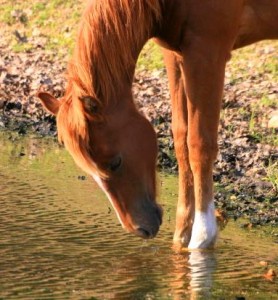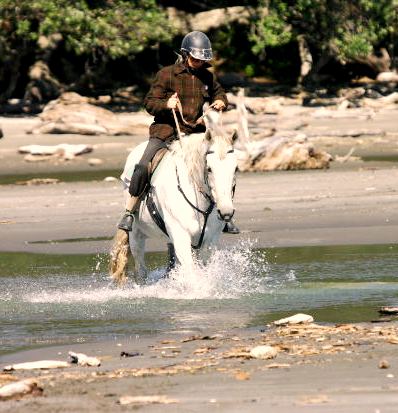 Walking through water can be one of the hardest things for a horse to accept, and his fear is often based on his past experiences. If he’s never seen it before, or if he’s been forced into it or struggled with by a rider over crossing water, then it’s going to be a big obstacle for him to overcome. No matter how much horse experience you have, when you’re working to overcome something like this you have to have a lot of patience and be willing to spend the time it takes to help the horse get past his fear of crossing water.
Walking through water can be one of the hardest things for a horse to accept, and his fear is often based on his past experiences. If he’s never seen it before, or if he’s been forced into it or struggled with by a rider over crossing water, then it’s going to be a big obstacle for him to overcome. No matter how much horse experience you have, when you’re working to overcome something like this you have to have a lot of patience and be willing to spend the time it takes to help the horse get past his fear of crossing water.
Whether you’re introducing your horse to water for the first time, or your trained horse has developed a problem with crossing water, you should start out by making a plan of action before you begin training your horse to cross water. Plan your training session in an area with a running stream, or if you don’t have access to streams or ponds, create your own “stream” by running water into a ditch or open space in a paddock. Just getting a horse used to walking through mud and water is a good idea for future rides.
Outfit your horse in just a halter and long lead rope. Bring him as close to the water as he will willingly come. Then just let him stand while you brush him or pat him. Don’t attempt to force him closer or get him to cross it. Your goal is to let him associate the water with good things, and if you make it a struggle or a punishment, he will always resist crossing water. Let him hang out by the water until he is relaxed, and then wade into it yourself, or step to the other side. Ask him to follow, but don’t make it a tug of war or a steady pull. Stay clear of his feet in case he does decide to jump over it, don’t let him land on you. Leave the lead rope slack so he can sniff, drink, or graze near the water’s edge. If you offer him a treat or handful of grass, he may decide to take a step into the water to reach the treat. Reward any forward progress with slack in the lead rope, petting, and praising. If you don’t get him to cross it in the first lesson, don’t despair. As long as your training was positive and encouraging, you haven’t lost ground, and he may walk right into the water the next time he is asked, because he wasn’t forced or taught to fear it.
You can also ask the horse to longe around you in a circle, and use your body position to move the horse closer and closer to the water, eventually asking him to move through the water to complete his circle. If he is adept and obedient at longeing, it shouldn’t take too much to get him to walk or trot right through the water. The repetitive action of moving in a circle will make it easier to merge him into the water without him realizing it or having a chance to resist. Once he does go through the water, repeat a few times, and then end the lesson on a positive note, or give him some other task. Come back the next day and repeat a few times. Just work crossing water into his daily schedule for a few weeks or until he never hesitates at it. It should feel completely natural and relaxed when you have practiced it enough.
Another good idea for getting a fearful horse to cross water is to let him follow a horse that is used to it. If the lead horse will walk into it willingly, chances are good that the inexperienced horse will walk through as well, if only to keep up with the lead horse. So get a friend to help you, and make the first lesson an easy one. If everything is calm and easy the first time a horse experiences it, then he probably will never develop a hang-up about water, and he’ll cross easy the rest of his life. Making your horse frustrated or really afraid when working with him to cross water will only worsen the problem. So if you can’t get him to cross easily, change tactics and try something else. Don’t force the issue and cause a blow-up.
When riding a horse through water, use the same principles outlined above. Encourage forward motion as you approach the water, but don’t get overly forceful. If the horse comes to a stop at the water’s edge, don’t take the spurs to him. Let him sniff, lower his head, look at the water, and otherwise check it out for safety. Giving him time should reassure him that 1.) the water is safe to cross, and 2.) his rider is sensitive to a horse’s need to inspect something that is frightening to him, and he will gain trust in you. After you’ve given him a moment, then ask him to continue, or at least give you forward motion. Even if he moves forward just a half of a step, praise him for obeying and let him pause again. You are reinforcing that his forward movement was the correct action by letting him pause. Being in a hurry will only work against you, so be sensitive to your horse and let him pause if he needs to. By asking for forward movement, blocking any movement to avoid or back away from the water, and praising him whenever he takes a step forward, your horse will gain the confidence he needs to handle water crossing with ease.
If your horse tends to leap into or over water, some additional training may be required. A good trail horse should cross water calmly, slowly, and steadily. So leaping is not desirable. One way to combat this is to direct your horse at an angle into the stream, rather than straight across it. Use rein contact to ask for a gradual ascent into the water, and don’t let the horse gather himself for a jump. Once you get him to step into the water, pat him, praise him, and let him know that was the correct action. You may need to practice on larger bodies of water (pond or lake) before he will be adept at it, as it narrow streams encourage a horse to just jump over and avoid the water completely. So work on getting the horse to accept the water and not to mind walking into a pond or the water’s edge. Lots of practice should reduce the jumping tendency.
Some additional tips about riding in water: Be aware that your horse may choose to lie down in it, especially if it’s hot or if he’s itchy. If your horse stops to paw in the water, or his knees begin to buckle, quickly urge him to keep moving, or you may find yourself in the water, too. Watch for drop-offs underwater, if you are riding through a river or deep stream. It is best to loosen the reins and trust the horse to choose the best route through water, but be ready to take control if necessary. Never ride a horse into deep water wearing a tie-down, as a horse will drown if he can’t raise his head above the water level to swim. Also, be on the alert for very sticky mud or other dangers when crossing water.
Following these guidelines will help teach your horse to calmly walk through water.

